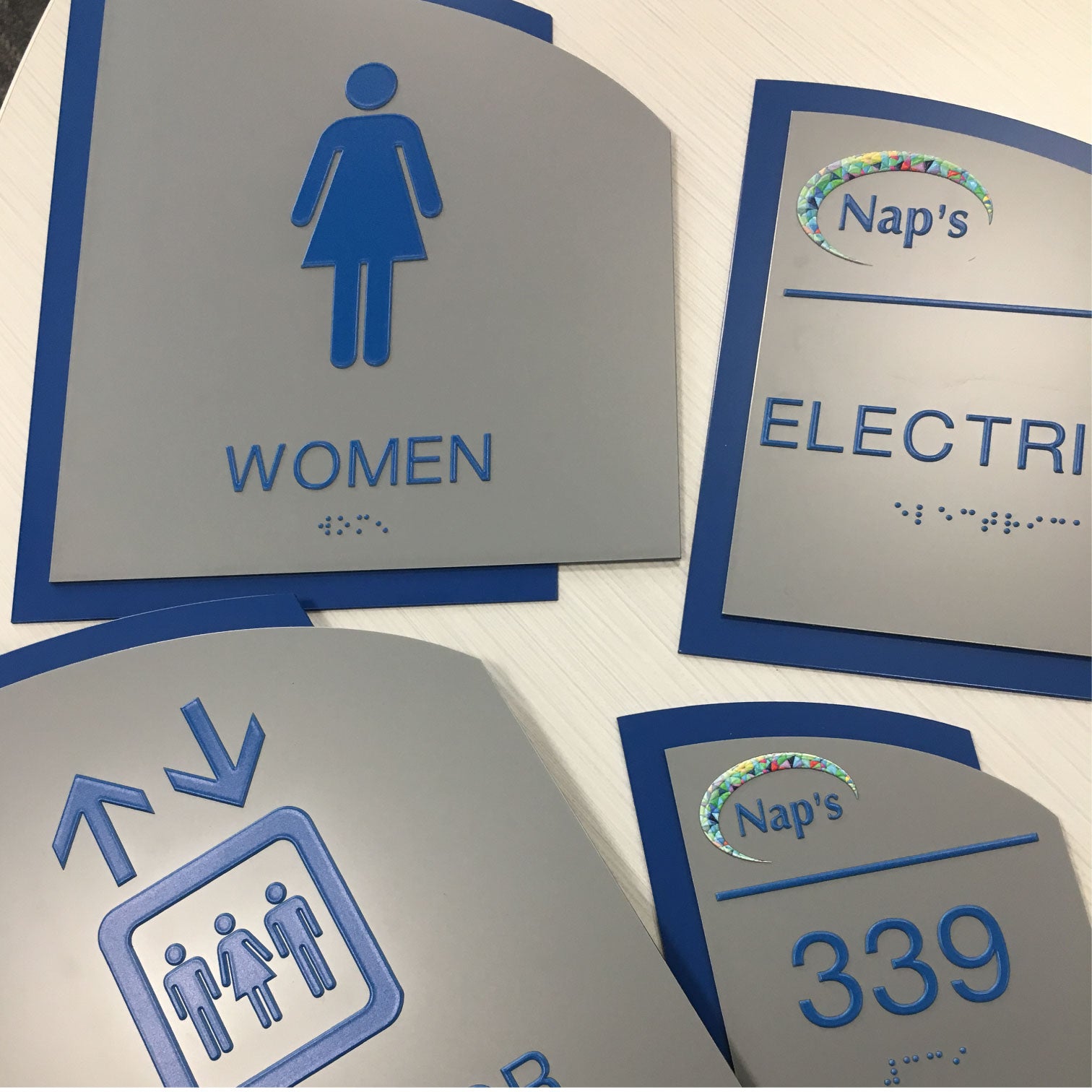Exploring Imaginative Designs for Reliable ADA Signs
Exploring Imaginative Designs for Reliable ADA Signs
Blog Article
Discovering the Trick Functions of ADA Indications for Boosted Access
In the world of access, ADA indicators act as quiet yet effective allies, guaranteeing that spaces are comprehensive and accessible for individuals with disabilities. By integrating Braille and responsive components, these indications break barriers for the aesthetically damaged, while high-contrast color pattern and understandable font styles provide to diverse visual demands. Their strategic positioning is not approximate however rather a computed effort to facilitate seamless navigation. Yet, beyond these attributes lies a much deeper narrative about the advancement of inclusivity and the continuous dedication to producing fair spaces. What much more could these indicators symbolize in our pursuit of global availability?
Value of ADA Conformity
Guaranteeing conformity with the Americans with Disabilities Act (ADA) is crucial for cultivating inclusivity and equal gain access to in public areas and work environments. The ADA, passed in 1990, mandates that all public centers, companies, and transportation services fit people with disabilities, ensuring they take pleasure in the very same legal rights and possibilities as others. Conformity with ADA standards not only satisfies legal responsibilities yet additionally boosts a company's online reputation by demonstrating its commitment to diversity and inclusivity.
One of the essential aspects of ADA compliance is the execution of available signage. ADA indicators are created to guarantee that individuals with handicaps can conveniently navigate via rooms and structures.
Additionally, adhering to ADA guidelines can alleviate the threat of possible penalties and legal effects. Organizations that stop working to abide by ADA guidelines may face fines or claims, which can be both economically troublesome and destructive to their public picture. Hence, ADA compliance is indispensable to promoting a fair setting for everybody.
Braille and Tactile Elements
The unification of Braille and tactile components right into ADA signage embodies the concepts of access and inclusivity. These attributes are critical for people that are visually impaired or blind, allowing them to browse public areas with higher freedom and confidence. Braille, a tactile writing system, is crucial in offering written info in a style that can be quickly regarded via touch. It is normally placed below the equivalent message on signage to guarantee that people can access the details without visual support.
Tactile aspects extend beyond Braille and include increased symbols and personalities. These parts are designed to be discernible by touch, allowing individuals to recognize area numbers, restrooms, leaves, and various other essential locations. The ADA establishes specific standards relating to the size, spacing, and placement of these responsive components to maximize readability and make sure consistency throughout various atmospheres.

High-Contrast Color Design
High-contrast color schemes play a crucial function in enhancing the presence and readability of ADA signage for individuals with visual problems. These plans are important as they make the most of the difference in light reflectance between text and history, guaranteeing that indicators are quickly discernible, even from a range. The Americans with Disabilities Act (ADA) mandates using certain color contrasts to fit those with restricted vision, making it a crucial element of compliance.
The effectiveness of high-contrast colors hinges on their ability to stick out in various lighting conditions, consisting of dimly lit settings and areas with glare. Typically, dark message on a light background or light text on a dark history is employed to achieve optimal comparison. For example, black text on a yellow or white background offers a stark aesthetic distinction that aids in quick acknowledgment and understanding.

Legible Fonts and Text Dimension
When considering the layout of ADA signage, the selection of readable font styles and proper text size can not be overstated. The Americans with Disabilities Act (ADA) mandates that font styles should be sans-serif and not italic, oblique, script, very attractive, or of unusual form.
According to ADA guidelines, the minimal text elevation must be 5/8 inch, and it should raise proportionally with viewing range. Consistency in message size adds to a natural visual experience, aiding people in navigating atmospheres efficiently.
In addition, spacing between lines and letters is indispensable to clarity. Adequate spacing stops characters from showing up crowded, improving readability. By sticking to these standards, developers can significantly enhance availability, guaranteeing that signs offers its intended function for all people, no matter of their visual abilities.
Reliable Positioning Techniques
Strategic placement of ADA signs is crucial for taking full advantage of availability and making sure compliance with legal criteria. ADA standards specify that indicators must be installed at a height between 48 to her comment is here 60 inches from the ground to ensure they are within the line of sight for both standing and seated people.
Furthermore, indicators have to be positioned surrounding to the latch side of doors to enable easy recognition before access. Uniformity in indication positioning throughout a center enhances predictability, minimizing complication and enhancing total customer experience.

Verdict
ADA indications play an essential function in advertising accessibility by incorporating features that attend to the needs of individuals with handicaps. These aspects jointly promote a comprehensive environment, emphasizing the significance of ADA compliance in making sure equal accessibility for all.
In the realm of accessibility, ADA signs offer as quiet yet powerful allies, making certain that rooms are accessible and comprehensive for individuals with disabilities. The ADA, enacted in 1990, mandates that all public centers, companies, and transportation services accommodate individuals with impairments, ensuring they enjoy the exact same rights and opportunities as others. ADA Signs. ADA indicators are created to make sure that people with disabilities can easily navigate through rooms and buildings. ADA guidelines specify that indications must be placed at a height in between 48 to 60 browse around these guys inches from the ground to ensure they are within the line of sight for both standing and seated people.ADA signs play an essential function in promoting availability by integrating functions that attend to the requirements of individuals with specials needs
Report this page